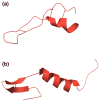An expanding universe of small proteins
- PMID: 21342783
- PMCID: PMC3079058
- DOI: 10.1016/j.mib.2011.01.007
An expanding universe of small proteins
Abstract
Historically, small proteins (sproteins) of less than 50 amino acids, in their final processed forms or genetically encoded as such, have been understudied. However, both serendipity and more recent focused efforts have led to the identification of a number of new sproteins in both Gram-negative and Gram-positive bacteria. Increasing evidence demonstrates that sproteins participate in a wide array of cellular processes and exhibit great diversity in their mechanisms of action, yet general principles of sprotein function are emerging. This review highlights examples of sproteins that participate in cell signaling, act as antibiotics and toxins, and serve as structural proteins. We also describe roles for sproteins in detecting and altering membrane features, acting as chaperones, and regulating the functions of larger proteins.
Published by Elsevier Ltd.
Figures


References
-
- Alix E, Blanc-Potard AB. Peptide-assisted degradation of the Salmonella MgtC virulence factor. EMBO J. 2008;27:546–557. MgtC is a conserved virulence factor that is subject to extensive transcriptional and post-transcriptional regulation. The authors of this paper show that the MgtR sprotein promotes the regulated proteolysis of MgtC by FtsH. - PMC - PubMed
-
- Alix E, Blanc-Potard AB. Hydrophobic peptides: novel regulators within bacterial membrane. Mol Microbiol. 2009;72:5–11. - PubMed
-
- Handler AA, Lim JE, Losick R. Peptide inhibitor of cytokinesis during sporulation in Bacillus subtilis. Mol Microbiol. 2008;68:588–599. Handler and colleagues describe how an FtsZ-interacting sprotein, MciZ, prevents the aberrant formation of divisional septa during endospore formation. Biochemical and genetic evidence suggest that MciZ interferes with FtsZ polymerization. - PMC - PubMed
-
- Hobbs EC, Astarita JL, Storz G. Small RNAs and small proteins involved in resistance to cell envelope stress and acid shock in Escherichia coli: analysis of a bar-coded mutant collection. J Bacteriol. 2010;192:59–67. DNA barcodes were employed to identify a range of sensitivity and resistance phenotypes associated with sprotein gene deletion mutants. This collection can be screened under virtually any stress condition for additional phenotypes that should provide springboards for sprotein characterization. - PMC - PubMed
Publication types
MeSH terms
Substances
Grants and funding
LinkOut - more resources
Full Text Sources
Molecular Biology Databases

